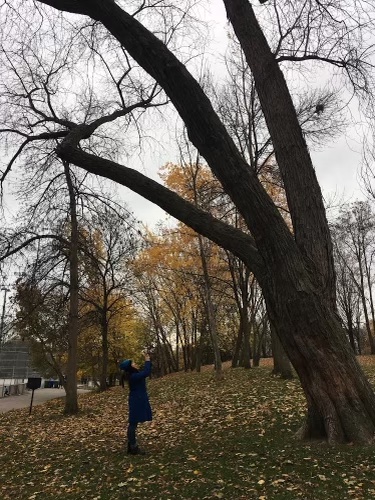
A small but important thing on our New Leadership To-Do List was to rename Ruff’s levels of giving. The original names, which had been around since the company was founded, had an implicit hierarchy that we wanted to move away from. We’re grateful for any donations, of any size – it’s all equally valuable to us – and we wanted the new names to reflect that. We also wanted to move a little farther away from the Shakespeare part of our name, and a little closer to the Ruff.
In November, PJ and Christine went on a scouting mission in Withrow Park to identify and acknowledge the beautiful trees that we play beneath. Here, Christine interviews PJ about their process.
Christine: PJ, can you talk a little bit about medicine plants and their importance? I know that’s an enormous question.
PJ: I think the connection, the roots, of plants and plant sources, their medicines– used in traditional medicinal practices for food and healing purposes– are a vital life source for us. There’s a direct relationship to respecting the earth, respecting nature and its plant life– that our recent ancestors knew inherently about. Understanding botany, medicines as resource– having gardens and cultivating these plants as food and healing agents is a form of cultural wisdom– a necessity in survival. And also, these plants, seeds, leafs, root systems are intrinsically used in art making and telling stories. An example of this is Métis Beadwork – and the invaluable knowledge and connection to family that those patterns hold.
Christine: Jack and Diane, the two big beautiful trees that Ruff performs under, are Willows. What did you learn about Willows when we were looking at the significance of the different trees in Withrow?
PJ: well, according to the interweb…
The Weeping Willow is a willow tree native to China. Historically traded along the Silk Road.
The Black Willow (which i think the Jack and Diane trees are–– are native to north america) is fast growing – can get to 43 metres! These trees can be mistaken for the Chinese trees….
But they are Indigenous to north america.
If a branch is cut– and placed in water–it can grow roots very easily!
Willows represent love, divination, protection. A path to stability, hope, healing.
Used to treat mastitis, toothaches, and scalds…the bark is used to treat rheumatoid arthritis, fevers, skin eruptions, and to purify the blood.
This is the tree/plant from which ‘aspirin’ originates. Funny thing not mentioned a lot of the time is…it’s all Indigenous medicine, ya know?
Christine: I was surprised that we discovered so many different kinds of trees in Withrow, which is teaching me to pay closer attention to the plant life around me. This question is a two parter: What was your favourite tree or plant that we looked at in the park? And can you talk about how we decided which trees to use when we were renaming our levels of giving?
PJ: It was a bit tricky to know which trees were accurately identified with our lovely plant app!— because their leaves had fallen— oh beautiful, cold and tricky fall season!
It’s hard to say which one is my favourite— they are life-force miracle plants— each with their own medicines and symbolisms….that’s what made choosing them so special— what each plant has the power to do..
I was so surprised by the lamb’s ear! That it was used as medical bandages in times of war—
Seeing the Nootka cypress— so distinct and cascading, full— love that tree!
I am especially partial to pines— they are powerful— and listening to them sing in the wind is remarkable… I highly recommend.
What’s your fave?
Christine: I have always loved birch trees. I love spotting their silvery white bark in a forest of green and brown. Doing our Withrow research, we learned that the silver birches in the park symbolize rebirth, protection, and new beginnings. Which feels pretty beautiful as we start our time at Ruff!
Our new levels of giving, named after the trees in Withrow, can be found here.


